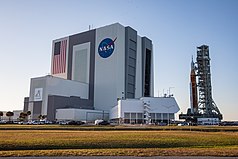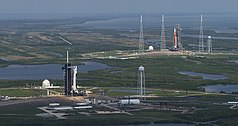 | |
Clockwise from the top: Vehicle Assembly Building, Shuttle Landing Facility, Launch Control Center, Launch Complex 39, KSC Headquarters Building, and the Visitor Complex | |
 KSC shown in white; CCSFS in green | |
| Abbreviation | KSC |
|---|---|
| Named after | John F. Kennedy |
| Formation | July 1, 1962 |
| Type | NASA facility |
| Location | |
| Coordinates | 28°31′27″N 80°39′03″W / 28.52417°N 80.65083°W |
| Owner | NASA |
Director | Janet E. Petro[1] |
Budget | US$2.074 billion[2]: 52 (2023) |
| Staff | 13,253[2]: 50 (2023) |
| Website | www |
Formerly called | Launch Operations Center |
| [3] | |
| Part of a series on the |
| United States space program |
|---|
  |
The John F. Kennedy Space Center (KSC, originally known as the NASA Launch Operations Center), located on Merritt Island, Florida, is one of the National Aeronautics and Space Administration's (NASA) ten field centers. Since 1968, KSC has been NASA's primary launch center of American spaceflight, research, and technology. Launch operations for the Apollo, Skylab and Space Shuttle programs were carried out from Kennedy Space Center Launch Complex 39 and managed by KSC.[4] Located on the east coast of Florida, KSC is adjacent to Cape Canaveral Space Force Station (CCSFS). The management of the two entities work very closely together, share resources, and operate facilities on each other's property.
Though the first Apollo flights and all Project Mercury and Project Gemini flights took off from the then-Cape Canaveral Air Force Station, the launches were managed by KSC and its previous organization, the Launch Operations Directorate.[5][6] Starting with the fourth Gemini mission, the NASA launch control center in Florida (Mercury Control Center, later the Launch Control Center) began handing off control of the vehicle to the Mission Control Center in Houston, shortly after liftoff; in prior missions it held control throughout the entire mission.[7][8]
Additionally, the center manages launch of robotic and commercial crew missions and researches food production and in-situ resource utilization for off-Earth exploration.[9] Since 2010, the center has worked to become a multi-user spaceport through industry partnerships,[10] even adding a new launch pad (LC-39C) in 2015.
There are about 700 facilities and buildings grouped throughout the center's 144,000 acres (580 km2).[11] Among the unique facilities at KSC are the 525-foot (160 m) tall Vehicle Assembly Building for stacking NASA's largest rockets, the Launch Control Center, which conducts space launches at KSC, the Operations and Checkout Building, which houses the astronauts' dormitories and suit-up area, a Space Station factory, and a 3-mile (4.8 km) long Shuttle Landing Facility. There is also a Visitor Complex on site that is open to the public.
- ^ Kennedy Space Center gets first woman director, Janet Petro, after Bob Cabana promoted to NASA.
- ^ a b "2023 Kennedy Space Center Annual Report" (PDF). NASA. Archived (PDF) from the original on January 2, 2024. Retrieved January 2, 2024.
- ^ "Kennedy Business Report" (PDF). Annual Report FY2010. NASA. February 2011. Retrieved August 22, 2011.
- ^ "Kennedy Space Center Implementing NASA's Strategies" (PDF). NASA. 2000. Archived from the original (PDF) on November 13, 2022. Retrieved November 5, 2015.
- ^ "Appendix 10 – Government Organizations Supporting Project Mercury". NASA History Program Office. NASA. Retrieved November 6, 2015.
- ^ "2. Project Support from the NASA Centers". Mercury Project Summary (NASA SP-45). NASA. October 1963. Retrieved November 6, 2015.
- ^ "Mercury Mission Control". NASA. Archived from the original on March 7, 2016. Retrieved November 6, 2015.
- ^ Lipartito, Kenneth; Butler, Orville (2007). 'A History of the Kennedy Space Center. University Press of Florida. ISBN 978-0-8130-3069-2.
- ^ "Research & Technology". Kennedy Space Center. NASA. March 3, 2015. Retrieved November 5, 2015.
- ^ "NASA Partnerships Launch Multi-User Spaceport". NASA. May 1, 2014. Retrieved November 5, 2015.
- ^ "Kennedy Creating New Master Plan". NASA. March 12, 2012. Archived from the original on May 27, 2020. Retrieved November 5, 2015.





